If you regularly exfoliate with lactic acid at home, your skin will lose many imperfections, become younger and gain a radiant, healthy color. The secret of the acid is that, without injuring the skin, it penetrates to the depths of the epidermis and cleanses it of keratinized particles, fat and other contaminants. In parallel with cleansing, the product moisturizes and nourishes the epidermis, increasing its tone and elasticity. As a result, you look young and fresh.
The principle of action and effectiveness of peeling with lactic acid
Peeling with lactic acid is a gentle way to renew the skin due to a chemical effect on it and accelerating regeneration. The described exfoliation refers to gentle, non-traumatic methods of exfoliation of the skin. The procedure is simple, so it can be done at home. The correct choice of concentration of the main product allows you to achieve optimal results. An exfoliant is lactic acid, which belongs to the class of alpha acids and produces a number of beneficial effects on the skin:
- Stimulation of collagen production;
- Regulating the functions of the sebaceous glands;
- Regulating the pH of the skin;
- Fights blackheads and acne;
- Provides increased elasticity;
- Creates a rejuvenation effect;
- Smoothes wrinkles;
- Produces cleansing, whitening, brightening and tightening;
- Fights microbes and inflammatory processes.
Lactic acid is found in yoghurt, cottage cheese, sour cream, and yogurt. Many women like to make masks from these products. Their effectiveness and ability to prolong youth is not an empty advertising sound, but a time-tested fact. Concentrated lactic acid acts more radically and has an even more rejuvenating effect on the skin.
Milk peeling at home quickly leads to the following effect:
- Oily shine goes away;
- Skin redness and inflammation disappear;
- Wrinkles are smoothed out;
- The relief of the face becomes smoother and clearer;
- Acne spots disappear;
- Pigmentation is eliminated;
- The skin becomes fresh, radiant, rejuvenated.
Exfoliation is not intended to eliminate deep wrinkles, stretch marks and scars. To eliminate serious deficiencies, you need to contact professional cosmetologists at the salon.
Did you know that the word “peeling” comes from the English “peel”, which translates as “scrape” or “sand”.
Are there any contraindications and side effects?
Any procedure, even the most harmless one, has contraindications. Milk peeling for the face is considered safe, so it can be done at home. However, even in this case, there are a small number of factors, the presence of which, the manipulation should be abandoned. This:
- Minor age;
- Lactation;
- Pregnancy;
- Malignant neoplasms on the skin;
- Tendency to form scar tissue;
- Recent depilation, solarium, tanning procedures;
- Spider veins on the face;
- Excessively sensitive skin;
- Presence of pigmented nevus;
- Individual intolerance to exfoliant;
- Aggravated herpes;
- Inflammatory processes on the face, purulent and other wounds.
You should be especially careful with chemical peels with high concentrations of lactic acid. This procedure should be carried out in a salon under the supervision of an experienced cosmetologist.
Even with a low concentration of exfoliant, it is necessary to strictly follow the instructions and not overexpose the active substance on the face and other parts of the body. With any peeling you need to know when to stop.
Rules for peeling from a cosmetologist
Facial peeling with lactic acid at home is carried out similarly to a cosmetic procedure. The manipulation is done in several stages:
- Sensitivity test.
- Preparation.
- Cleansing.
- Direct exfoliation.
- Completion of the procedure.
The manipulation doesn't end there. For several days after it, the skin requires special attention and special care.
The precursor to everything should be a test. It should be done the day before exfoliation to determine the reaction to the exfoliant. Testing is carried out on the wrist, where a weakly concentrated solution of the active substance is applied. If there are no reactions in the form of itching and redness, the procedure can be carried out.
Cosmetologists recommend avoiding visiting beaches and solariums approximately 2 weeks before the procedure. Do not use sunscreen. If you notice herpetic rashes, start taking antiviral medications. In order for the skin to get used to lactic acid, use creams containing an exfoliant at the preparatory stage.
Before treating your face with the active substance, cleanse the skin of fatty contaminants and cosmetic residues. To do this, use your usual cleansers. Then carry out degreasing. The best remedy would be a tonic containing fruit acids. If you don't have it, you can use alcohol. It is necessary to treat the face without affecting the nasolabial area and under the eyes. It is better to lubricate these places with Vaseline.
Direct treatment involves applying an exfoliant solution of varying concentrations to the face. Before doing milk peeling, decide for yourself how much time you will spend on the procedure. If you are doing it for the first time, if your skin is dry, it is better to keep the product on for no more than half a minute. Already during the next manipulations, increase the time by 30 seconds.
It is best to apply the product with a brush, but cotton pads will also work. Make sure that the drug does not spread. Avoid contact with mucous membranes. Start applying from the forehead and then massage down to the chin. If you feel a burning sensation, direct a stream of cool air onto your face. To do this, prepare a hairdryer in advance.
Immediately after the prescribed time has expired, rinse off the product with plenty of cool water. Next, apply a moisturizing mask to the treatment area. It should be kept for at least 15 minutes and then rinsed off with cool water. The final touch is the application of a nourishing cream, preferably containing aloe oil.
As noted earlier, for a few more days your facial skin will need your increased attention.
Milk peeling recipes at home
Before doing lactic acid peeling at home, choose the most suitable recipe for yourself. Let's give an example with a weakly concentrated exfoliant, only 4%. 10 gr. The drug must contain:
- Lactic acid – 0.5 g;
- Water, preferably distilled – 9.5 g.
Before you make a lactic acid peel, which you will use at home, take care of a product that neutralizes the acid. The neutralizer will provide safe and painless exfoliation. An effective product is made from:
- 1 teaspoon of soda;
- 1 cup distilled water.
It is important to prepare the exfoliant itself correctly: you should always add the active substance to the water, and not vice versa. This is the only way you will get high-quality milk peeling at home, which acts as an effective scrub.
The concentration shown is suitable for initial procedures, when the skin is not yet accustomed to the exfoliant and may react negatively to it. The optimal concentration for home use is 25%. The toughest and most painful option is 80%.
Milk peeling for the face from fermented milk products at home can have an extremely low concentration. As already noted, both sour milk and sour cream will have a cleansing effect. These products are good for women and girls. At any age, they will treat and rejuvenate the skin, saturating it with necessary substances.
For light peeling you can use the following recipe:
- 1 tablespoon of fat sour cream;
- 1 yolk;
- 1 teaspoon chopped oatmeal;
- 1 teaspoon lemon juice.
First, the yolk and oatmeal are mixed, then the remaining ingredients are stirred until smooth. The product is applied for 3 minutes with massaging movements and then washed off.
Cosmetologists recommend carrying out the procedure once a week. The effect will be visible after approximately 8-10 procedures for those with oily skin and after 4-5 procedures for those with combination and normal skin.
This is interesting: the first professional peelings were used back in XIX century in Germany. Cosmetologists of the century before last used resorcinol and salicylic acid.
How to care for your skin after procedures
After milk peeling, you need to completely stop using creams that contain fruit acids and retinoids for several days. For 2 days you should not touch the skin of your face.
In the following days, you should treat your face with moisturizers. For the first 10 days, try to avoid direct sunlight on the treated areas.
For many women, the important question is whether the skin will peel off. The answer to this can be either positive or negative. The final effect depends on the concentration you choose and the properties of the skin: dry skin will give up faster, oily skin will last a little longer.
Summary
Milk peeling at home can be made from fermented milk products - the most gentle method, or lactic acid. The initial concentration should be minimal to allow the skin reaction to be determined. Then you can increase the percentage of distilled water and exfoliant. Gradually, you will determine the optimal concentration for individual use and will be able to provide your skin with regular cleansing and care.
Homemade peeling with lactic acid, gently, without injuring the skin, will help cleanse the epidermis of impurities and keratinized particles, while nourishing and moisturizing it, increasing elasticity and tone. This peeling procedure is a good way to prolong the youth, beauty and freshness of the skin.
Content:
- What is lactic acid peeling?
- Effect of milk peeling
- Indications for peeling
- Contraindications for milk peeling
- Peeling with lactic acid, stages of behavior at home
- Recommendations for skin care after peeling with lactic acid
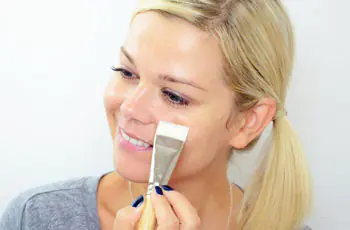
What is lactic acid peeling?
Lactic acid peeling is a superficial chemical peeling, but is a more gentle and non-traumatic method of skin exfoliation. The main active ingredient is lactic acid (belongs to alpha acids), which has a number of beneficial properties for the skin:
- Has antimicrobial and anti-inflammatory effects.
- Cleanses, moisturizes, whitens, tightens the skin.
- Smoothes wrinkles, increases skin elasticity, rejuvenates.
- Fights acne, blackheads, regulates skin pH.
- Regulates the functioning of the sebaceous glands.
- Stimulates collagen production.
Masks with sour cream, cottage cheese, yogurt, and curdled milk can be considered a “simple” milk peeling at home. Such procedures are popular among women and have a good effect on the condition of the skin, and are also absolutely harmless, since the content of lactic acid in them is minimal. For peeling carried out in the salon, lactic acid is used in varying concentrations (30-80%). In each specific case, depending on the condition of the skin and individual characteristics, the specialist prescribes a certain concentration of acid for application, the frequency of the peeling procedure, as well as its necessity.
Effect of milk peeling
- The skin is moisturized, filled with natural radiance, and there are no pigment spots.
- The skin texture is evened out and acne spots disappear.
- Wrinkles are smoothed out.
- Inflammation and redness are eliminated.
- Eliminates oily shine.
Remember, peeling with lactic acid at home can improve the condition of the skin, but it cannot get rid of deep wrinkles, scars and scars.
Indications for peeling
- Unhealthy or dull complexion.
- Hyperpigmentation.
- Flaccid skin and loss of tone.
- Expression wrinkles.
- Inflammatory processes and irritations on the skin.
- Enlarged pores.
- Blackheads, pimples, excessively oily, sebaceous skin.
Milk peeling can be used after 25 years, but before doing it, it is advisable to consult a doctor for contraindications, of which there are many.
Contraindications for milk peeling
- Pustular open wounds on the face, skin damage, severe inflammation, swelling.
- Herpes is in the acute stage.
- Individual intolerance.
- Pigmented nevus.
- Increased sensitivity of facial skin.
- For spider veins on the face, the concentration of acid used should be minimal.
- Skin after tanning, depilation, solarium.
- Presence of a tendency to form scar tissue.
- Skin neoplasms of a malignant nature.
- Age up to 18 years.
- Pregnancy and lactation period.
To carry out home peeling, you must purchase a solution of lactic acid and strictly follow the recommendations described below. The peeling procedure is quite simple and does not require long recovery. Visible results will be noticeable after several peeling procedures.
Video: Homemade facial peeling with lactic acid.
Peeling with lactic acid, stages of behavior at home
To carry out peeling you will need: lactic acid itself, cotton pads (for the first procedure it is better to take cotton swabs), cleanser (lotion, gel, foam), tonic with fruit or lactic acid, or alcohol (90%). Peeling is carried out in several stages:
Stage 1. Preparation for peeling.
- 10-14 days before peeling, you need to stop using sunscreen, avoid solariums and tanning in the open sun.
- In case of herpetic rashes, take antiviral agents during two weeks of preparation.
- During this period, use cosmetics containing low concentrations of lactic acid (cream with fruit acids, tonics, etc.) to allow the skin to get used to the effects of the substance and eliminate the consequences of its aggressive influence.
Stage 2. Cleansing.
Immediately before treating the skin, it is necessary to cleanse the face of makeup and other contaminants with a regular cleanser. Next, the skin needs to be degreased, for which use a tonic with fruit acids (can be replaced with alcohol), moistening a cotton pad and wiping the skin. We do not touch the skin around the eyes and nasolabial area! To be on the safe side, lubricate the area around the eyes and the skin of the lips with Vaseline.
Stage 3. Sensitivity test.
Before the peeling procedure, it is important to conduct a sensitivity test. To do this, use a weak solution of lactic acid. Apply the solution to the skin of the wrist and wait a few minutes. If negative reactions occur (severe itching, unbearable burning, etc.), rinse the solution with cool water and do not use it on the face.
Stage 4. Treatment of the skin with a solution or direct peeling.
Cosmetologists in salons use a solution of lactic acid with a concentration of 30-80% for peeling and hold it for 5-20 minutes, taking into account the condition and type of skin. At home, it is better to start with small concentrations of the active substance (25%) with a minimum exposure time (30 seconds-1 minute, taking into account the type of skin, for oily skin you can keep it for up to one minute), gradually increasing them to 30% and 2-3 minutes. To obtain a solution of lactic acid of the required concentration, it is mixed with purified water in the ratio specified in the instructions for the drug. It is convenient to apply the peeling composition with a brush, but cotton pads are also suitable. When applying acid to the skin, it is important to remember that the cotton pads should not be too soaked with it and should not leak. When applying, care should be taken so that the substance does not get on the mucous membranes. Application begins from the forehead and cheeks, moving along the massage lines. If you feel a strong feeling of discomfort or burning, you can direct a stream of cool air from a fan or hairdryer onto your face.
Stage 5. Completion of the procedure.
At the end of the solution’s exposure time, wash with plenty of cool (not warm!) water. You need to wipe your face with a soft towel using blotting movements. Immediately after this, apply a mask with an intense moisturizing and soothing effect, keep for 15 minutes, rinse with cool water. Finally, lubricate the skin with nourishing cream with oils and aloe.
Recommendations for skin care after peeling with lactic acid
In the first few days after peeling, you should use moisturizers and temporarily avoid creams containing retinoids and fruit acids. You can't go out in the sun for two weeks. Do not touch your face for 2 days.
Peeling with lactic acid with a minimum concentration of 25% is best done continuously every seven days, observing the skin reaction. The peeling results will be noticeable after about the fourth procedure for those with combination and normal skin; for oily skin types, the peeling effect may appear after 8-10 procedures. In case of any negative manifestations, the procedure should be stopped and the solution should be washed off with plenty of cool water.
Peeling with lactic acid will help rejuvenate and refresh your facial skin without damaging it. It acts so gently that it can be used even on very sensitive skin when other products are not suitable.
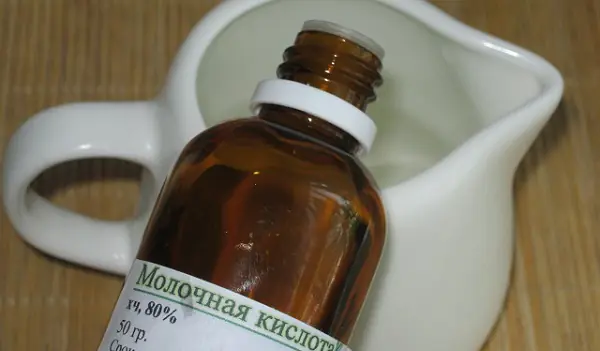
Operating principle of milk peeling
Lactic acid affects the top layer of the skin - the epidermis. At the same time, dead skin cells are exfoliated, collagen and elastin are actively produced - substances on which its elasticity and tone depend.
You can feel the changes immediately, but the peeling will have to be repeated for a visible effect. 3-5 times with a break of 10-15 days.
How to make milk peeling
For peeling with lactic acid at home you will need:
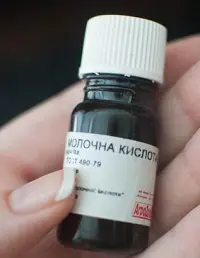
Lactic acid solution (from 30 to 70%, can be purchased at the pharmacy) - for the first time, choose the lowest percentage or be sure to dilute with water (otherwise a burn may occur). It is recommended to first make a 5% solution - this is approximately half 1 pipette of product for 16 whole pipettes of water.- Regular cotton pads
- Medical alcohol,
- Hair dryer (optional).
Stages of the procedure:
Start with preparation. Wash your face with water and cleanser, pat your face dry with a towel. Then degrease the skin: use a cotton pad soaked in alcohol to wipe your face, starting from the forehead and moving to the neck. Apply the solution generously lactic acid on a cotton pad, but do not overdo it so that the product does not drip. Apply to the face, also starting from the top, trying not to get it on the skin in the area of the lips and eyes. You can protect these areas with Vaseline or a thick cream. Note the time. The duration of the first procedure is no more than 1-2 minutes. If you experience burning or tingling sensations, use a hairdryer - simply direct a stream of cool air onto your face, this will help reduce discomfort. However, if the burning becomes unbearable, the procedure should be stopped to avoid chemical burns. Wash your face with cool water over time (warm or hot water can cause severe redness and irritation). You can apply the moisturizer that you are used to using.Video instruction
When performing repeated procedures, listen to your feelings. If you feel accustomed to the product, you can increase the concentration of lactic acid and the peeling time.
A very simple option for peeling with lactic acid at home - using masks with products containing lactic acid (kefir, sour cream, cottage cheese, whey).
You can wash your face with milk in the morning.
Recipe for a curd mask - find out.
Face mask with sour cream - recipe.
With prolonged use, these manipulations will also give a good effect.
Indications
The procedure is suitable for you if you have the following facial skin problems:
- High sensitivity or allergy to other types of chemical peels,
- There is acne, black spots on the face, increased sebum secretion,
- There is hyperpigmentation, freckles,
- Expression wrinkles appear, elasticity is lost,
- Unhealthy, dull complexion.
Before and After the procedure - photos
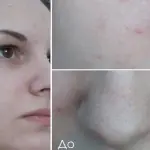
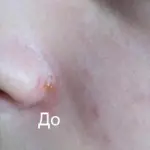
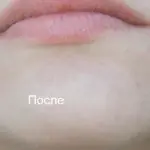


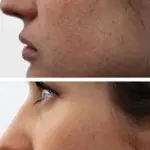
Who can't?
Contraindications to peeling with lactic acid include:
- Oncological diseases,
- Pregnancy and lactation period,
- Diabetes,
- Skin diseases,
- Open wounds, ulcers, pustules,
- The period of exacerbation of herpes.
We recommend reading:
Find out the recipe for Victoria Boni's secret peeling: photos and videos.
7 magical properties of almond peeling - more details.
Premium brand mousse for milk peeling
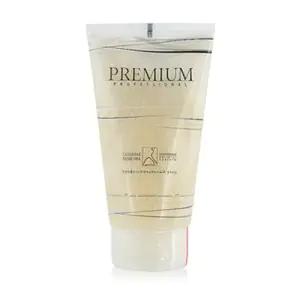
To carry out peeling at home, you can use compositions for professional care, for example, “Milk Mousse” peeling with lactic acid from the Russian brand Premium.
The mousse has a pleasant aroma and soft texture and is especially gentle on the skin. Unlike a pharmaceutical solution, you need to apply the mousse for 10 minutes.
As a result of the procedure, the complexion looks whiter and more even, the skin becomes fresh and moisturized.
When used once a week, the product lasts for more than a year, which fully justifies its cost.
Reviews
Marina: I did milk facial peeling in the salon - after a course of procedures, my problematic skin was unrecognizable, acne completely disappeared, it became lighter and younger, completely renewed.
Christina: It didn’t work for me, the acne didn’t go away, only irritation appeared. Perhaps I mixed the ingredients incorrectly, because... I did it myself. They say you have to dilute it, but I didn’t. So be careful.
Julia: I like to make a kefir mask a couple of times a month with the addition of 1 drop of lactic acid from the pharmacy, leave it on for 5 minutes and wash it off. My face is always clean and fresh, I recommend it.




